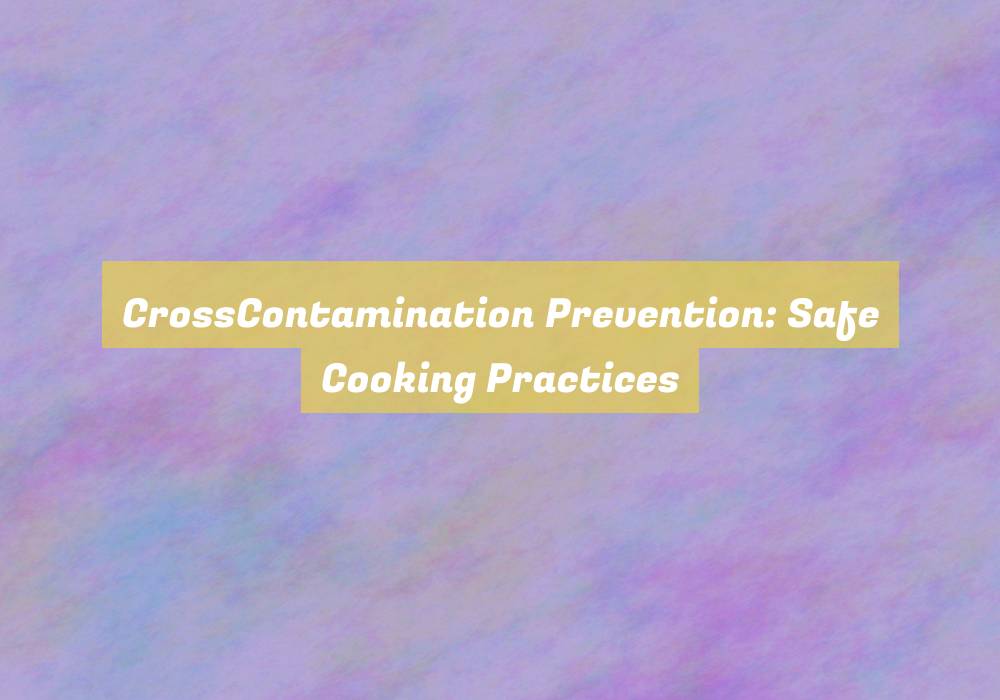CrossContamination Prevention: Safe Cooking Practices
When it comes to creating a safe and healthy meal, you want to ensure that every step of the cooking process is handled with care. Just as a conductor meticulously guides an orchestra through a symphony, you must orchestrate your kitchen practices with precision to prevent the risk of cross-contamination.
But how exactly can you ensure that your cooking practices are as safe as possible? Stay tuned to discover the crucial importance of safe cooking practices and gain valuable tips for preventing cross-contamination in your kitchen.
Understanding Cross-Contamination
Understanding cross-contamination is crucial for maintaining food safety in your kitchen. Cross-contamination occurs when bacteria or other microorganisms are unintentionally transferred from one surface or food to another. This can happen through direct contact, such as when raw meat juices come into contact with ready-to-eat foods, or through indirect contact, such as using the same cutting board or utensils for raw and cooked foods without proper cleaning in between.
To prevent cross-contamination, itG??s important to practice good food handling and preparation techniques. Always wash your hands thoroughly with soap and water before and after handling food, especially raw meat, poultry, and seafood. Use separate cutting boards and utensils for raw and cooked foods, and wash them with hot, soapy water between uses.
Additionally, be cautious of any surfaces or equipment that may come into contact with raw foods, such as countertops, sinks, and refrigerator handles. Regularly sanitize these areas to reduce the risk of cross-contamination.
Importance of Safe Cooking Practices
To ensure the safety of your meals, itG??s essential to implement safe cooking practices that build upon your understanding of cross-contamination in the kitchen. By following safe cooking practices, you can significantly reduce the risk of foodborne illnesses and ensure that the meals you prepare are safe for consumption.
One of the key reasons why safe cooking practices are crucial is the prevention of cross-contamination. When you handle and cook food safely, you minimize the chances of harmful bacteria spreading from one food to another, which can lead to foodborne illnesses.
Additionally, safe cooking practices help to preserve the nutritional value of the food you prepare. Overcooking or undercooking food can lead to a loss of essential nutrients, and by following safe cooking techniques, you can ensure that your meals retain their nutritional benefits.
Furthermore, safe cooking practices contribute to maintaining the quality and flavor of the food. Proper cooking methods and temperatures help to preserve the taste and texture of the ingredients, resulting in more enjoyable and satisfying meals for you and your family.
Therefore, itG??s crucial to prioritize safe cooking practices in your kitchen to safeguard your health and well-being.
Tips for Preventing Cross-Contamination
To prevent cross-contamination in your kitchen, implement strict cleanliness practices when handling raw meats and other perishable foods. Always use separate cutting boards and utensils for raw meats and ready-to-eat foods to avoid the transfer of harmful bacteria.
Wash your hands thoroughly with soap and warm water before and after handling raw meats, as well as after touching any surfaces or utensils that may have come into contact with the raw meat. ItG??s important to clean and sanitize countertops, cutting boards, and utensils after theyG??ve been in contact with raw meats to prevent the spread of bacteria to other foods.
When storing raw meats in the refrigerator, place them on the bottom shelf or in a designated meat drawer to prevent any drips or leaks from contaminating other foods. Use airtight containers to store raw meats to avoid any juices from dripping onto other items. Additionally, ensure that your refrigerator is set to the appropriate temperature to keep perishable foods safe.
Implementing Safe Kitchen Habits
When cooking in your kitchen, prioritize safe habits to minimize the risk of foodborne illness. Start by washing your hands thoroughly with soap and warm water before and after handling food, especially raw meat, poultry, seafood, or eggs.
Use separate cutting boards for raw meat and produce to prevent cross-contamination. Ensure that your kitchen surfaces and utensils are clean and sanitized regularly.
Keep raw meats refrigerated and separate from other foods to avoid the spread of harmful bacteria. When cooking, use a food thermometer to ensure that meats are cooked to the appropriate internal temperature to kill any harmful pathogens.
Be mindful of expiration dates on food products and discard any items that have passed their prime. Store leftover food promptly in the refrigerator to prevent the growth of bacteria.
Additionally, avoid using the same utensils or plates for raw and cooked foods. By implementing these safe kitchen habits, you can significantly reduce the risk of foodborne illnesses and ensure the safety of the meals you prepare.
Conclusion
In conclusion, practicing safe cooking habits is essential in preventing cross-contamination and foodborne illnesses. By understanding the risks of cross-contamination and implementing good kitchen habits, you can protect yourself and your loved ones from getting sick.
Remember to keep raw and cooked foods separate, clean and sanitize kitchen surfaces, and wash your hands frequently. These simple steps can make a big difference in keeping your kitchen safe and your food delicious.
Stay safe and happy cooking!





